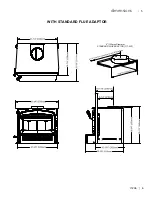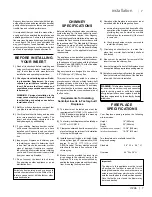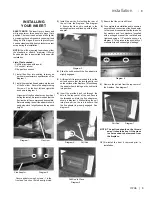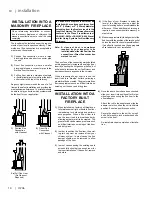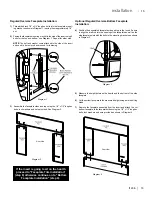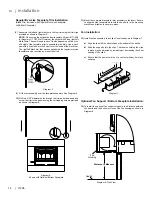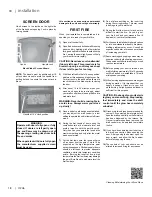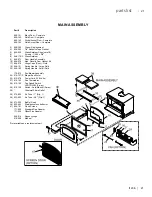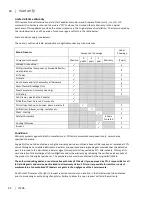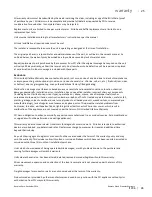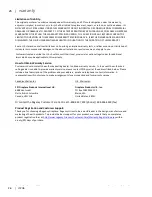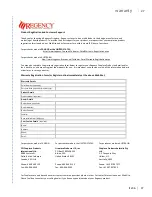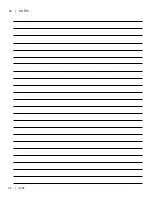
I1205 | 19
19
|
operating instructions
be burned in your insert.
15)
Do not store any fuel closer than 2 feet from
your unit.
16)
Do not burn salt drift wood as it will corrode
your unit and void the warranty.
17)
Do not strike or slam the glass door shut as
this may cause the glass to break.
18)
Do not operate the unit if the glass is broken
or missing. Do not operate the unit if the
gasketing is worn out and not sealing the
door or the glass.
It is very important to carefully maintain your
insert, including burning seasoned wood and
maintaining a clean stove and chimney system.
Have the chimney cleaned before the burning
season and as necessary during the season, as
creosote deposits may build up rapidly. Moving
parts of your insert require no lubrication.
CREOSOTE
When wood is burned slowly, it produces tar and
other organic vapors, which form creosote when
combined with moisture. The creosote vapors
condense in the relatively cool chimney flue of a
slow-burning fire. As a result, creosote residue
accumulates on the flue lining. When ignited, this
creosote can make an extremely hot fire.
Removal for Cleaning etc.
Removal of your insert for cleaning purposes
is usually not required if a proper installation
has been done. In the event that removal is re-
quired, be sure not to damage any parts needed
for re-installation. In most cases removal and
replacement of the baffle system should allow
full access for cleaning.
WARNING: Things to remember in case
of chimney fire
:
1) Close draft control
2) Call the Fire Department
Ways to Prevent and
Keep Unit Free of Creosote
1)
Burn insert with draft control wide open for
about 15 minutes every morning during burn
-
ing season. This helps to prevent creosote
deposits within the heating system.
2)
Burn insert with draft control wide open for
about 10 - 15 minutes every time you add
fresh wood. This allows the wood to achieve
the charcoal stage faster and burns up any
wood vapors which might otherwise be
FAN OPERATION
The fan is to be operated only with the draft
control rod
pulled out at least 1/2" from the
fully closed position.
The fan is not to be
operated when the draft control rod is in the
closed position (pushed in). The fully closed
position is the low burn setting.
The fan must not be turned on until a fire has
been burning for at least 30 minutes. Also note
it is recommended that the fan be turned off
before each fuel loading and again wait for 30
minutes before the fan is turned on again. This
is too allow the stove to reach it's optimum
temperature.
To operate fan automatically, push switch on
side of fan housing to "Auto" and second switch
to either "High" or "Low" for fan speed. The
automatic temperature sensor will engage the
blower when the unit is at temperature and will
shut off the blower once the fire has gone out
and the unit has cooled to below a useful heat
output range.
To manually operate the fan system, push the
first switch to "Man" and second switch to either
"high" or "Low". This will bypass the sensing
device and allow full control of the fan. Switching
from "Auto" to "Manual" or "High" to "Low" may
be done at any time.
ASH DISPOSAL
During constant use, ashes should be removed
every few days. Please take care to prevent the
build-up of ash around the start-up air housing
located inside the firebox, under the loading
door lip.
DO NOT ALLOW ASHES TO BUILD UP TO
THE LOADING DOORS.
Only remove ashes when the fire has died down.
Even then, expect to find a few hot embers.
Always leave 1 to 2 inches of ash in the bottom
of the firebox. This helps in easier starting and
a more uniform burn of your fire.
Ashes should be placed in a metal container with
a tight fitting lid. The closed container of ashes
should be placed on a noncombustible floor or
on the ground, well away from all combustible
materials, pending final disposal. If the ashes
are disposed of by burial in soil or otherwise
locally dispersed, they should be retained in the
closed container until all cinders have thoroughly
cooled. Other waste should not be placed in
the ash container.
SOME SAFETY
GUIDELINES
1)
Never use gasoline, gasoline type lantern fu-
els, kerosene, charcoal lighter fuel, or similar
liquids or chemicals to start or ‘freshen up’ a
fire in your insert. Keep all such liquids well
away from the heater while it is in use.
2)
Never use alternate fuels such as charcoal
that have the possibility of generating carbon
monoxide.
3)
Keep the door closed during operation and
maintain all seals in good condition.
4)
Do not burn large quantities of paper in your
insert.
5)
Do not burn garbage or flammable fluids.
6)
If you have smoke detectors, prevent smoke
spillage as this may set off a false alarm.
7)
Do not overfire your insert. If the insert or its
flue baffle begin to glow, you are overfiring.
Stop adding fuel and close the draft control.
Overfiring can cause extensive damage to
your stove including warpage and premature
steel corrosion. Overfiring will void your
warranty.
8)
Do not permit creosote or soot buildup in the
chimney system. Check and clean chimney
at regular intervals.
9)
Your Regency Insert can be very hot. You
may be seriously burned if you touch the
insert while it is operating. Warn children of
the burn hazard. Keep furniture and clothing
away.
10)
The insert consumes air while operating,
provide adequate ventilation with an air
duct or open a window while the insert is in
use.
11)
Do not use grates, irons or other methods
for supporting fuel. Burn directly on the
bricks.
12)
Open the draft control fully for 10 to 15
seconds prior to slowly opening the door
when refuelling the fire.
13)
Do not connect your unit to any air distribu-
tion duct.
14)
Your insert should burn dry, standard fire
-
wood only. The use of “mill ends” is discour
-
aged as this fuel can easily overheat your
insert. Evidence of excessive overheating
will void your warranty. As well, a large por-
tion of sawmill waste is chemically treated
lumber, which is illegal to burn in many areas.
Chemically treated fire logs also must not
Summary of Contents for Classic I1205M
Page 25: ...Encastrable au bois Regency I1200 25 notes ...
Page 30: ...30 Encastrable au bois Regency I1200 garantie ...
Page 31: ...Encastrable au bois Regency I1200 31 ...
Page 60: ...28 I1205 28 warranty ...
Page 61: ...I1205 29 29 notes ...
Page 62: ...30 I1205 30 notes ...
Page 63: ...I1205 31 31 ...

